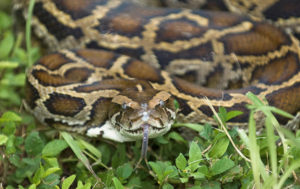By Jack Payne
A snake so voracious it can swallow a fully-grown deer prowls the Everglades.

An insect’s arrival in Florida seemed innocuous enough until the discovery that it carries a fungus that kills avocado trees.
A spiny newcomer to Florida is eating fish that could have been on your plate, and it is wreaking havoc on coral reefs that are crucial to supporting underwater life and the economy back on shore.
These are invasions by species that are not native to Florida. The Burmese python, the red bay ambrosia beetle and the lionfish are considered invasive species because they are non-native species that also cause environmental or economic damage.
National Invasive Species Awareness Week was one way we at the University of Florida’s Institute of Food and Agricultural Sciences (UF/IFAS) helped tell the story about how invasive species devour our crops, close lakes to boating, and rewrite both the entrees and the prices on menus. Fighting these invasions requires spending of tens of millions of your tax dollars in Florida alone each year.
Figuring out how to prevent or control invasive species is a challenge so vast that premier public research universities must play a role in any substantial response.
Scientists often group themselves by their academic degrees – entomology, ecology, plant pathology, and on and on. Great public universities make themselves most useful when we can group scientists around a problem.
That’s why the University of Florida’s Institute of Food and Agricultural Sciences (UF/IFAS) has responded to the call for expertise in invasion science.
We don’t employ “invasion scientists.” But we know that almost any of our faculty can be one with the right resources and opportunities. That’s why UF/IFAS awards grants to scientists to come together from different fields to research invasions.
It’s also why we invited in experts from New Zealand, Canada, South Africa, and across the U.S. for a recent three-day workshop in Gainesville to start organizing effective scientific responses to invasive species.
Bringing experts together leads to more creative responses than if they all worked in isolation.
And invasion science is creative. Consider just the Burmese python. UF/IFAS has cooperated with the Florida Fish and Wildlife Conservation Commission (FWC) on bringing in snake-sniffing dogs from Auburn University and Irula tribesmen from India in hopes of teaching Floridians how to find and catch pythons. We even sent an intrepid post-doctoral researcher traipsing into the Everglades to detect whether the mosquitoes who feasted on him were also feeding on the pythons.
UF/IFAS received what’s believed to be the first U.S. Department of Agriculture-funded grant in decades for research in Cuba to scout for forest pests before they get here.
You can help. How?
- If you’re not sure what to plant in your yard, please visit assessment.ifas.ufl.edu to get the lowdown on the invasion risk posed by hundreds of non-native plant species.
- Don’t release pet reptiles, amphibians or any other store-bought critters into the wild. You could be detonating the next invasive species explosion.
- If you see strange plants or animals, report them using the IVEGOT1 hotline, web page or app. FWC does a great job helping to manage invasives. UF/IFAS Extension offices can also help you find the right people to identify or respond to wildlife that could pose problems.
- Join a citizen science effort, such as our School of Ants that gathers data on native and invasive species.
It’s a team effort. UF/IFAS scientists are working, for example, on helping wildlife managers triage the myriad reports of wildlife encounters they receive. The tool will help guide which calls require the most urgent response.
The 1,000 people a day who move here are not the only ones looking to set up a life in Florida. Plants, insects, and animals are also trying to make their way in.
The rise of invasion science at UF/IFAS is an example of how valuable publicly funded research is to a state that grows many of the nation’s winter vegetables and attracts 100 million annual visitors. Cutting-edge research will allow Florida to continue welcoming visitors while limiting harm from new arrivals that push out native Florida plants and animals.

Jack Payne is the University of Florida’s senior vice president for agriculture and natural resources and leader of the Institute of Food and Agricultural Sciences. You can reach out to him on Twitter @JackPayneIFAS or via e-mail at jackpayne@ufl.edu.


Leave a Reply